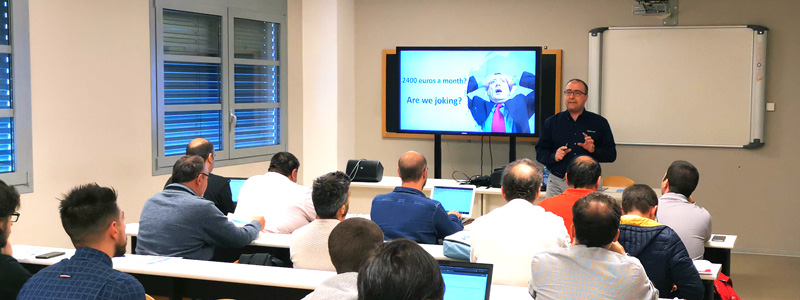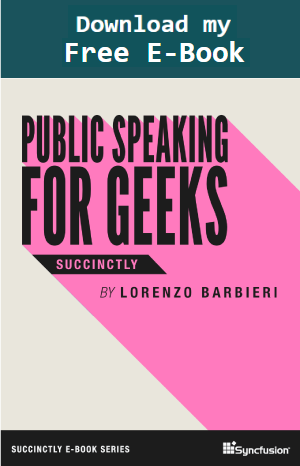This post was written by my friend Massimo Bonanni.
I like talking in public! I like the adrenaline that you feel immediately before going on stage. I love to prepare the session, think about the “fil-rouge” that guides the discussion, the dry-runs before the event.
I started in 2009, and I’m a perfectionist: when I do something that I like, I always try to improve myself (if I can).
For this reason, during the last ten years, I followed workshops, online courses, read dozens of books and tried to keep, from those who are professionals, how to be effective when telling stories to someone.
I think that if you would like to talk to people (whether they are 10 or 100 or 1000, it doesn’t matter), you must always give the best you can. The people who are listening to you are sacrificing their time. You can’t make it wasted time.
If I look back, I can see that my approach to the sessions is changed: my slides have become slimmer, with less text and more precise. Progressively the bullet points disappeared to leave space to other ways to visualize lists of elements. The number of slides has also decreased over time.
My way of telling also changed over time, but it is not the only thing change. Even the way I follow other people’s sessions changed.
In the last period, I don’t follow the session to understand the topic (not only) but to catch new teachings or possible mistakes from the speaker.
In this post, I would like to report some common mistakes mentioned in many of the workshops I followed (primarily Lorenzo’s) and that I often see in the sessions.
In my opinion, a session must split into three parts: the introduction, the central part, and the conclusion.
Introduction
For what about the introduction, I have often heard speakers hesitantly starting their presentation. The start of a session is fundamental; it is the moment when you catch the people in the room and bring them with you. If you make a great intro, you get the people’s attention; otherwise, it will be difficult to involve attendees.
During the last years, I understood that the introduction (and the conclusion) must be learned by heart, and it must be effective. It is the moment in which you capture the attention of the attendees, and it is therefore fundamental.
Another mistake I see in many sessions is that the speaker presents the first slide with his “Palmares” (first name, last name, job title, mail, web site, social, all the achieved badge, certification, his dog name, the home address, and so on).
He spends a lot of time describing who she is and what she does.
I think she is wasting time because, if the attendees know her, the slide is unuseful; otherwise, if the attendees don’t know her, this isn’t the right way to introduce herself.
Furthermore, the initial slide remains on the screen for a short time, and the people in the room cannot save the references, and, further, they are distracted by the introduction (which we said is very important).
I prefer to show my reference (only my references, not all my life) in the Q&A slide because that slide is on the screen for all the Q&A time, and the attendees can save them by taking the necessary time.
Another thing that I don’t like in a technical session (especially when it has a small duration) is the agenda. The agenda is unuseful because what you are talking about must be evident in the abstract of the session, and your attendees probably read the abstract.
The Central Part
In the central part of the session, you follow the “fil-rouge,” you thought when you create the speech. If you can, don’t change the “fil rouge” but you must be ready to do so if the situation requires it.
A couple of years ago, at the beginning of a technical session, I realized that the people in the room didn’t have the necessary preparation to follow the topic (which was advanced). For this reason, I extended, on the fly, the introduction part and removed some advanced arguments.
Of course, I tried to do that without changing the content of the session.
If I hadn’t done that, most of the attendees couldn’t follow what I had to say, and the session would have been useless.
Another thing to do during your central part of the speech is to look at the attendees. While you talk, you should look at the attendees in the face, one by one. In this way, you will make them feel involved, and the session will be more appreciated.
Of course, you don’t have to do (Lorenzo always says) as “the garden sprinkler”.
You are talking to your audience, and when you speak to someone, you generally look at him.
Moreover, during the whole session, you should vary your tone of voice. If you change it, you avoid that people do not get bored or fall asleep (especially for those sessions that occur after the lunch break). Changing the tone of the voice is a technique also used by theater actors.
Conclusion
The third part is the conclusion. It is similar to the introduction, and it must learn by heart.
Here you give the key points of your session (that are what the people in the room will remember from the session) and, why not, receive the applause from your attendees.
You must have it in mind, and you don’t have to change on-the-fly for any reason. Your attendees will remember it because it is the last thing they listen to, so it is essential as the introduction.
However, first, close the session and, only later, open the Q&A phase.
Generally, in the Q&A phase, I show my reference to the attendees. That slide remains on the screen for all the Q&A phase so the attendees can take your references.
My conclusion
Finally, to close this post, I think that you cannot do an excellent presentation if you don’t make some dry-runs before the event. The dry-run allows you to check your “fil-rouge”, your body language, the session duration, and so on. I know many speakers didn’t make dry-runs, and believe me, it shows!!!
I’m an Azure Technical Trainer in Microsoft, and speaking in public is my job. Also, for ten years, I have been a technical speaker at the most prestigious Italian and international conferences. For these reasons, Lorenzo asks me to write a post with my journey into the public speaking world.
I’m honored to be a guest in PublicSpeaking.Dev, and I want to thank Lorenzo for this opportunity and, even more, for teaching me a lot about public speaking and encouraging me to read, study and update myself continuously.

